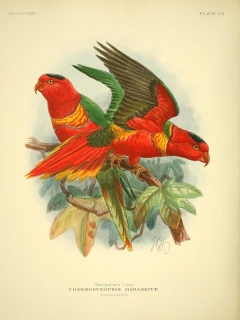Duchess Lorikeet |
|
|
Also known as: Margaret's Lorikeet, Princess Margaret's Lorikeet
Species Profile
Genus: Charmosyna | Species: margarethae
Size:
20cm (7.8 in)
Weight:
40-60g (1.4-2.1 oz)
Subspecies including nominate:
one
Colour Adult:
Male- mainly bright red in colour; purple/black hindcrown to occiput; olive/green rump and upper tail coverts; wide yellow band across chest; thin yellow collar on mantle bordered above by purple/black line; dull mauve/black lower breast; underwing band dull yellow; red tail tipped with yellow. Bill orange. Eye yellow/orange. Female- as in male but with yellow patches on sides of rump.
Colour Juvenile:
Breast band yellow and faint; yellow collar on mantle with dusky wash; red hindcrown to occiput washed with dusky black; black markings on feathers of head and underparts. Bill brown/black. Eye pale grey.
Call:
Calls made in flight are loud and high-pitched; high-pitched screek notes emitted while feeding. Calls are in general more squeaky than other lorikeets.
Listen NowVideo Links:
Video 1More Information:
Content Sources:
CITES
BirdLife International
Cornell Lab of Ornithology/Birds of the World
Parrots: A Guide to Parrots of the World, Juniper and Parr, 1998
Parrots of the World, Forshaw, 2006. 2010 edition
Lexicon of Parrots, Thomas Arndt.
Species Care
Captive Status:
Not usually found in aviculture.
Longevity:
Not recorded.
Housing:
Flight 2 x 1 x 2m (6.5 x 3.3 x 6.5 ft) with plantings, minimum temperature 25C (77 F).
Diet:
Nectar made from porridge, honey, pollen, vitamin, yeast and multivitamin supplements; also dry feed of oatmeal, dextrose, pollen, calcium powder and calcium phosphate; fruits such as: apple, pear, banana, mango, guava, and commercial lory food.
Enrichment:
Not recorded.
Nest Box Size:
Not recorded.
Clutch Size:
Not recorded.
Incubation Time:
Not recorded.
Fledging Age:
Not recorded.
Hatch Weight:
Not recorded.
Peak Weight:
Not recorded.
Weaning Weight:
Not recorded.
Species Wild Status
World Population:
Unknown, decreasing.
IUCN Red List Status:
Near Threatened
CITES Listing:
Appendix II
Threat Summary:
A BirdLife 'restricted-range' species. Is described as widespread and common, although rare on Santa Isabel island in the Solomon Islands. May be threatened should any large scale international trade begin.
Range:
Bougainville, E Papua New Guinea, and Gizo, Kolombangara, Guadalcanal, Santa Isabel, Malaita, and San Cristobal, Solomon Islands.
Habitat:
Found from 100-1350m (328-4428 ft) in forest and woodland, forest edge and tall secondary growth, mainly in mountains and hills, and occasionally in coastal coconut plantations and villages.
Wild Diet:
Feeds on pollen, nectar and soft fruits, in particular Schefflera.
Ecology and Behaviour:
Feeds in noisy groups of 10-40 individuals in flowering trees and epiphytes, mixing with other species of lories. When resting or in smaller groups fairly quiet and inconspicuous.
Clutch and Egg Size:
Not recorded.
Breeding Season:
January
Members Only Resources
Please log-in now to find more research, resources and tools.
Not a Member?
Find more great information:
Gain exclusive access to 600+ pages of additional research, seminars and podcasts, specialists to ask your toughest questions, and dozens of other fun resources - when you become a WPT member.
Join Today >>

































